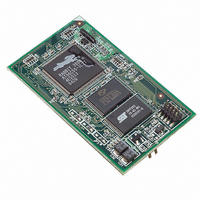20-101-0673 Rabbit Semiconductor, 20-101-0673 Datasheet - Page 22

20-101-0673
Manufacturer Part Number
20-101-0673
Description
MODULE RABBITCORE RCM3610
Manufacturer
Rabbit Semiconductor
Datasheet
1.20-101-0673.pdf
(136 pages)
Specifications of 20-101-0673
Module/board Type
MPU Core Module
Product
Microcontroller Modules
Core Processor
Rabbit 3000
Clock Speed
22.1 MHz
Interface Type
Serial
Flash
256 KB
Timers
10 x 8 bit, 1 x 10 bit
Operating Supply Voltage
3 V to 3.6 V
Board Size
31 mm x 54 mm x 16 mm
Core
RCM3610
Processor Series
RCM3600
For Use With/related Products
RCM3610
Lead Free Status / RoHS Status
Lead free / RoHS Compliant
Other names
316-1103
- Current page: 22 of 136
- Download datasheet (3Mb)
3.2.1 Serial Communication
The following sample programs can be found in the Dynamic C
SERIAL
•
•
16
FLOWCONTROL.C
CTS/RTS with serial data coming from Serial Port D (TxD) at 115,200 bps. The serial
data received are displayed in the
To set up the Prototyping Board, you will need to tie TxD and RxD
together on the RS-232 header at J2, and you will also tie TxC and
RxC together using the jumpers supplied in the Development Kit as
shown in the diagram.
A repeating triangular pattern should print out in the
The program will periodically switch flow control on or off to demonstrate the effect of
no flow control.
Refer to the function description for
Function Reference Manual for a general description on how to set up flow-control
lines.
PARITY.C
repeatedly sending byte values 0–127 from Serial Port D to Serial Port
C. The program will switch between generating parity or not on Serial
Port D. Serial Port C will always be checking parity, so parity errors
should occur during every other sequence.
To set up the Prototyping Board, you will need to tie TxD and RxC together on the
RS-232 header at J2 using the 0.1" jumpers supplied in the Development Kit as shown
in the diagram.
The Dynamic C
NOTE: PE5 is set up to enable/disable the RS-232 chip on the Prototyping Board. This
folder.
BitWrPortI(PEDR, &PEDRShadow, 0, 5);//set low to enable rs232 device
pin will also be toggled when you run RS-232 sample programs on the Prototyping
Board. If you plan to use this pin for something else while you are running any of the
RS-232 sample programs, comment out the following line.
—This program demonstrates the use of parity modes by
STDIO
—This program demonstrates how to configure Serial Port C for
window will display the error sequence.
STDIO
serDflowcontrolOn()
window.
STDIO
window.
SAMPLES\RCM3600\
in the Dynamic C
RabbitCore RCM3600
Related parts for 20-101-0673
Image
Part Number
Description
Manufacturer
Datasheet
Request
R

Part Number:
Description:
COMPUTER SGL-BRD BL2500 29.4MHZ
Manufacturer:
Rabbit Semiconductor
Datasheet:

Part Number:
Description:
COMPUTER SGL-BRD BL2500 29.4MHZ
Manufacturer:
Rabbit Semiconductor
Datasheet:

Part Number:
Description:
DISPLAY GRAPHIC 12KEY PROG OP670
Manufacturer:
Rabbit Semiconductor
Datasheet:

Part Number:
Description:
DISPLAY GRAPHIC 12KEY ETH OP6700
Manufacturer:
Rabbit Semiconductor
Datasheet:

Part Number:
Description:
COMPUTER SINGLE-BOARD BL2030
Manufacturer:
Rabbit Semiconductor

Part Number:
Description:
COMPUTER SGL-BOARD ETH BL2010
Manufacturer:
Rabbit Semiconductor

Part Number:
Description:
MODULE OP6810 W/O ETH/MEM EXPANS
Manufacturer:
Rabbit Semiconductor
Datasheet:

Part Number:
Description:
COMPUTER SINGLE-BOARD BL2020
Manufacturer:
Rabbit Semiconductor

Part Number:
Description:
COMPUTER BL2010 W/FRICTION LOCK
Manufacturer:
Rabbit Semiconductor

Part Number:
Description:
COMPUTER BL2020 W/FRICTION LOCK
Manufacturer:
Rabbit Semiconductor

Part Number:
Description:
COMPUTER SGL-BRD BL2500 44.2MHZ
Manufacturer:
Rabbit Semiconductor
Datasheet:

Part Number:
Description:
COMPUTER SGL-BOARD FULL BL2000
Manufacturer:
Rabbit Semiconductor

Part Number:
Description:
COMPUTER SINGLE-BOARD BL2110
Manufacturer:
Rabbit Semiconductor

Part Number:
Description:
COMPUTER SGL-BRD 29.4MHZ BL2610
Manufacturer:
Rabbit Semiconductor
Datasheet:

Part Number:
Description:
INTERFACE OP6800 512K FLASH&SRAM
Manufacturer:
Rabbit Semiconductor
Datasheet:










